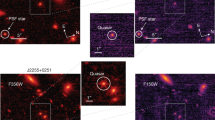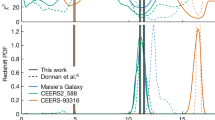Abstract
THE most distant astronomical objects observed are quasars at redshifts of z ≈ 4.9 (ref. 1), corresponding to a time when the Universe was less than a billion years old. This leaves little time during which the quasars and their host galaxies could form2. In principle, the evolutionary state of the host galaxies can be probed by determining how many stars have formed, but this task is not straightforward because light from the quasar itself overwhelms any accompanying starlight. High-redshift radio galaxies—the likely progenitors of luminous elliptical galaxies3—provide better targets for such studies, as optical emissions from their active nuclei are observed to be faint. Here we report the discovery of a radio galaxy (6C0140 + 326) at z = 4.41 which shows no evidence for either a stellar continuum or an unobscured quasar nucleus. We conclude that the galaxy associated with the radio source is neither fully formed nor obviously in the process of forming stars. This implies that at least some giant elliptical galaxies are still immature at z ≈ 4.5, and that if the intense bursts of star formation thought to produce the bulk of their stellar populations occur during the radio-bright phase, these star-forming regions are obscured by dust and gas.
This is a preview of subscription content, access via your institution
Access options
Subscribe to this journal
Receive 51 print issues and online access
$199.00 per year
only $3.90 per issue
Buy this article
- Purchase on Springer Link
- Instant access to full article PDF
Prices may be subject to local taxes which are calculated during checkout
Similar content being viewed by others
References
Schneider, D. P., Schmidt, M. & Gunn, J. E. Astron. J. 102, 837–840 (1991).
Efstathiou, G. & Rees, M. J. Mon. Not. R. Astron. Soc. 230, 5P–11P (1988).
Eales, S. A. & Rawlings, S. Astrophys. J. 460, 68–93 (1996).
Owen, F. N. & Laing, R. A. Mon. Not. R. Astron. Soc. 238, 357–378 (1989).
Lilly, S. J. Astrophys. J. 333, 161–167 (1988).
Chambers, K. C., Miley, G. K. & van Breugel, W. J. M. Astrophys. J. 363, 21–39 (1990).
Rawlings, S., Eales, S. & Warren, S. Mon. Not. R. Astron. Soc. 243, 14P–18P (1990).
McCarthy, P. J. Annu. Rev. Astron. Astrophys. 31, 639–688 (1993).
Eales, S. A. & Rawlings, S. Astrophys. J. 411, 67–88 (1993).
Dunlop, J. S. & Peacock, J. A. Mon. Wot. R. Astron. Soc. 263, 936–966 (1993).
Lacy, M. et al. Mon. Not. R. Astron. Soc. 271, 504–512 (1994).
Spinrad, H., Dey, A. & Graham, J. R. Astrophys. J. 438, L51–L54 (1995).
Eales, S. A. Mon. Not. R. Astron. Soc. 217, 149–166 (1985).
Krolik, J. H. & Chen, W. Astron. J. 102, 1659–1662 (1991).
Neeser, M. et al. Astrophys. J. 451, 76–87 (1995).
Peacock, J. A. Mon. Not. R. Astron. Soc. 199, 987–1006 (1982).
Rawlings, S. & Saunders, R. Nature 349, 138–140 (1991).
Dickson, R. et al. Mon. Not. R. Astron. Soc. 273, L29–L33 (1995).
Eales, S. et al. Nature 363, 140–142 (1993).
Eisenhardt, P. & Dickinson, M. Astrophys. J. 399, L47–L50 (1992).
Kormendy, J. & Djorgovski, S. Annu. Rev. Astron. Astrophys. 27, 235–277 (1989).
Kennicutt, R. C. Astrophys. J. 388, 310–327 (1992).
Steidel, C. C. et al. Astrophys. J. 462, L17–L21 (1996).
Eales, S. A. et al. Mon. Not. R. Astron. Soc. (in the press).
Hu, E. M. & McMahon, R. G. Nature 382, 231–233 (1996).
Djorgovski, S. G. et al. Nature 382, 234–236 (1996).
Dunlop, J. S. et al. Nature 370, 347–349 (1994).
Ivison, R. J. Mon. Not. R. Astron. Soc. 275, L33–L36 (1995).
Omont, A. et al. Nature 382, 428–431 (1996).
Ohta, K. et al. Nature 382, 426–428 (1996).
Dunlop, J. S. et al. Nature 381, 581–584 (1996).
Loveday, J. et al. Astrophys. J. 390, 338–344 (1992).
Bruzual, A. & Charlot, S. Astrophys. J. 405, 538–553 (1993).
Author information
Authors and Affiliations
Rights and permissions
About this article
Cite this article
Rawlings, S., Lacy, M., Blundell, K. et al. A radio galaxy at redshift 4.41. Nature 383, 502–505 (1996). https://doi.org/10.1038/383502a0
Received:
Accepted:
Issue Date:
DOI: https://doi.org/10.1038/383502a0
This article is cited by
-
Distant radio galaxies and their environments
The Astronomy and Astrophysics Review (2008)
-
Ultrasensitive solution-cast quantum dot photodetectors
Nature (2006)
-
The inevitable youthfulness of known high-redshift radio galaxies
Nature (1999)
Comments
By submitting a comment you agree to abide by our Terms and Community Guidelines. If you find something abusive or that does not comply with our terms or guidelines please flag it as inappropriate.



